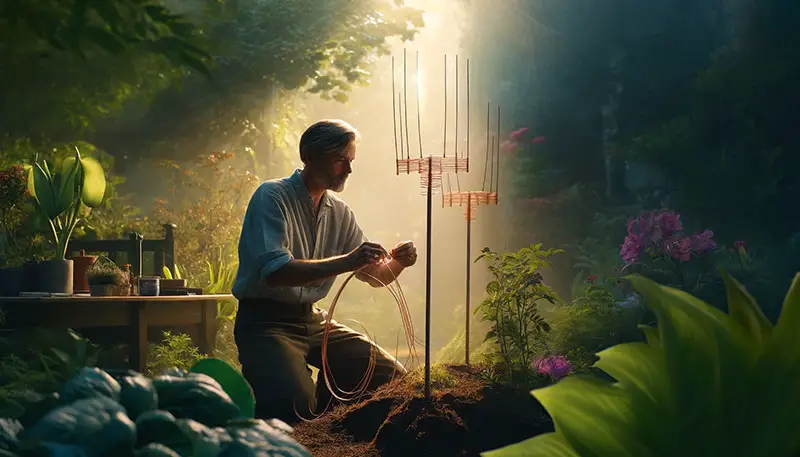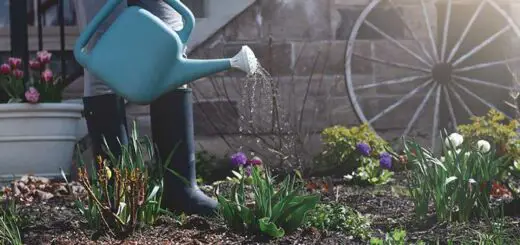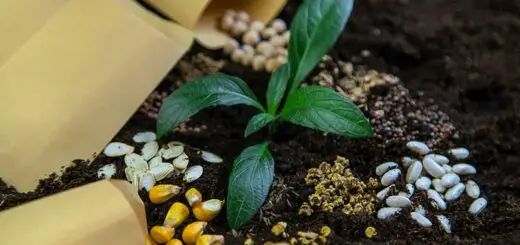How to Make Electroculture Antennas: A DIY Guide
Welcome to today’s blog post, where we’ll explore an intriguing practice called electric culture. This method involves using copper wire to harness positive and negative atmospheric charges that are naturally present around us.
The goal is to enhance plant growth, increase yields, create healthier plants, reduce pest issues, and improve nutrient uptake. Intrigued? Let’s explore how you can make your electroculture antenna at home.
Buy Copper Wire from Amazon Top Rated Seller
What You’ll Need
- Copper Wire: Opt for as pure copper as you can find, which is more conductive. A thickness of around 3 mm is ideal because it’s stiff enough to hold its shape well. You might need about 10 to 20 meters, depending on how many antennas you plan to make.
- Four-foot Canes: They will serve as the structure to wrap your wire around. Bamboo canes are a great choice.
- Drill: Handy to make a starting hole in the cane if necessary.

Step-by-Step Guide
- Prepare the Cane: Start by ensuring your cane is ready to be worked with. If the bottom isn’t hollow, you should carefully use a drill to create a starter hole. This helps in securing the wire to begin wrapping.
- Attach the Wire: Insert the end of your copper wire into the bottom of the cane. Push it up until it reaches the first knuckle of the cane. This helps prevent the wire from unraveling as you coil it around the cane.
- Begin Wrapping: For those in the Northern Hemisphere, wrap the wire clockwise around the cane; if you’re in the Southern Hemisphere, go anti-clockwise. Start at the bottom, where you’ve secured the wire, and work your way up. It’s not about perfection; feel free to eyeball the spacing between wraps. Generally, one full twist every hand-width is a good measure.
- Finish the Top: Once you reach the top of the cane, extend the wire a few inches over the top and cut it off. Loop or bend the end to create a safe end, avoiding sharp points that might cause injury.
- Plant the Antenna: Push the cane into the ground, ensuring that at least six inches of the wired cane is buried. This enhances the antenna’s stability and effectiveness.
Buy Copper Wire from Amazon Top Rated Seller
Why It Works (The Theory)
The concept behind electroculture is fascinating yet needs to be fully understood. It’s based on the idea that everything around us carries an electric charge. Introducing a copper antenna into the environment might allow you to draw down and utilize these natural electric fields to stimulate plant growth.
Customization and Variations
There’s a lot of room for creativity with electroculture antennas. Some enthusiasts prefer shorter canes with more coils, resembling a screw, which are especially popular for use in pots to help with seedling germination. Feel free to experiment with different designs and see what works best for your garden.
Buy Copper Wire from Amazon Top Rated Seller
You may want to read this article on Copper Wire for the Garden: The Electroculture Technique
Your Garden Diary
Final Thoughts
Electroculture is still a field ripe with experimentation. There isn’t a one-size-fits-all approach and much of what can be discovered comes from personal trial and error. Whether or not the science is fully understood, the potential benefits it might bring to your gardening endeavors make it a worthwhile experiment.
Remember, safety comes first! Ensure that all wire ends are adequately secured to avoid accidents. Happy gardening, and here’s to hope your plants thrive with an electric boost!
Buy Copper Wire from Amazon Top Rated Seller
References and Further Reading
After thorough research and practice, inspired by various sources and YouTube videos, I crafted my own Electroculture Antennas. Here are a few links that provided invaluable guidance and insights into this process:
- YouTube Video on Making Electroculture Antennas: Watch here for a practical demonstration on making your own antennas, a resource that was instrumental in guiding my project.
These resources were crucial in helping me understand the detailed aspects of electroculture and create effective antennas to enhance plant growth in my garden.



